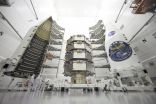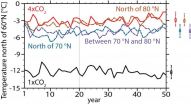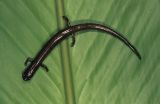"To get to this point in time, we had to overcome a number of engineering challenges," said Brent Robertson, the deputy project manager of the Magnetospheric Multiscale (MMS) mission, led by NASA's Goddard Space Flight Center in Greenbelt, Maryland, where hundreds of employees and contractors spent five years simultaneously building the four spacecraft, each equipped with 25 sensors and other components provided by more than 40 partner institutions in the U.S., Europe, and Japan.
The mission, whose scientific investigations are led by Principal Investigator James Burch, of the Southwest Research Institute in San Antonio, Texas, launched aboard a United Launch Alliance Atlas V 421 rocket in on March 12, 2015.
"These technologies and engineering efforts were necessary to allow MMS to meet its objective of understanding magnetic reconnection" -- the fundamental, yet poorly understood process that MMS was specifically designed to study, Robertson added.
While reconnection occurs throughout the universe when magnetic field lines within plasma connect and disconnect, here, it can impact our technological society, since it drives virtually all space weather events that can disrupt low-Earth-orbiting spacecraft and lead to communications and power blackouts on Earth.
NASA has never before flown a mission dedicated exclusively to studying this phenomenon, let alone with four precisely aligned, spinning spacecraft, each roughly the size of Fenway Park when each of the satellite's eight booms fully deploy. "No one has done what we're going to do," said MMS Deputy Mission Systems Engineer Gary Davis.
During the mission's first phase, which begins in September, the spacecraft will travel through reconnection sites on the sun-side of Earth, where the orbit extends out toward the sun to around 47,500 miles. About one year later, ground controllers then will move the spacecraft to Earth's night-side or magnetotail where the magnetic fields also reconnect -- an orbit that extends away from Earth to almost 99,000 miles, nearly halfway to the moon.
Navigation Technologies Crucial
However, science operations can't begin before the four move into a highly elliptical orbit and assume their pyramid-shape formation that places the spinning spacecraft just 6.2 miles (10 kilometers) apart. It required a breakthrough to accomplish such an exacting formation, Robertson said, and the Goddard-developed Navigator GPS provided the solution.
Begun in the early 2000s as an enabling technology for MMS-type missions, the Navigator receiver and associated algorithms can quickly acquire and track Global Positioning System (GPS) radiowaves even in weak-signal areas well above GPS's 30-plus-satellite constellation positioned about 12,550 miles above Earth. In addition to continuously tracking weak signals, the Navigator also must operate as the spacecraft spin at three revolutions per minute. As a result, each MMS satellite is equipped with two Navigator receivers (primary and redundant), with four antennas placed around the perimeter of each, assuring continuous contact with the tracked GPS satellites.
To the satisfaction of the technology's architect, Goddard technologist Luke Winternitz, the receivers have proven very robust. Shortly after the GPS receivers were powered on after the launch, Navigator became, at more than 43,000 miles (70,000 kilometers) above Earth's surface, the highest-ever operational GPS receiver in space. "We're tracking up to 12 GPS satellites at maximum altitude and track on average about nine," Winternitz said. "We're really excited about their performance so far."
Because the MMS spacecraft must maintain a precise formation, the mission also needed the ability to not only determine the immediate locations of the four observatories, but also predict where they would be in the future and how fast they would be traveling. Providing that predictive data is the Goddard Enhanced Onboard Navigation System (GEONS), created by Goddard technologist Russell Carpenter and his collaborator, Anne Long, a technologist with A.I. Solutions, a Lanham, Maryland-based contractor.
"Almost all activities associated with operating the mission depend on where the satellites will be positioned a few days hence," Long explained. That includes everything from determining the best time to downlink telemetry and scientific data to calculating when ground controllers would command the firing of the satellites' onboard thrusters, which move and help maintain their orbital formation -- an exercise that will happen at least once every couple weeks. "You need to plan the formation in advance," she said.
Enter a New S-band Antenna
Communicating commands to the MMS fleet also required the MMS team to rethink the onboard hardware it would use, said Adán Rodríguez-Arroyo, another Goddard technologist who developed a newfangled, diminutive S-band antenna that met the mission's communications requirements. "It is a good example of innovation at Goddard," he said.
Typically, omnidirectional antennas on spinning spacecraft are positioned in the middle of a spacecraft to assure a direct line of sight to ground stations. With MMS, however, instrument booms needed to occupy that real estate, leaving mission planners with very few options as to where to place hardware so essential for receiving and transmitting telemetry, housekeeping, and scientific data. Further complicating the challenge was the fact that the antennas could not be too close to the surface of the spacecraft because of potential degradation caused by reflection and refraction.
The new S-band antenna overcame these obstacles. This concept incorporated two 3-inch antenna elements integrated atop a two-foot mast, all into one assembly that neither interfered with other instruments nor added too much weight or complexity. Each spacecraft carries two, one on top of the observatory, the other below.
"We needed to keep the antenna light because every pound matters. Furthermore we didn't want the antenna to block an instrument's view," Davis said. "It's a spindly little thing. I can't believe it can communicate from half-way to the Moon."
So Much Data, So Little Bandwidth
However, it wouldn't have mattered how well the S-band antenna performed had it not been for a data-compression technology developed by now-retired Goddard technologist Penshu Yeh. The communications hardware simply wouldn't have been able to handle the copious amounts of data collected by one instrument in particular, the Goddard-developed Fast Plasma Investigation (FPI).
Designed to measure the pressure, temperature, and heat flow of plasmas, FPI is expected to generate a megabyte of data per second on each of the four spacecraft -- a rate analogous to streaming video over a computer. While easy on Earth with high-speed Internet, it's difficult in space where the data rate would quickly overwhelm the mission's S-band allocation for downlinking data.
"We were up against basic laws of physics," said Tom Moore, the MMS project scientist at Goddard who also worked on FPI. "There's only so much data you can get down."
In 2004, Yeh had already begun developing a next-generation data-compression algorithm on application-specific integrated circuits. Four years later, she and her partner, the University of Idaho's Center for Advanced Microelectronics and Biomolecular Research, successfully fabricated two radiation-hardened processors -- the Discrete Wavelet Transformer and a Bit Plane Encoder, funded by NASA's Space Communication and Navigation office. The chip set can compress 20 megabytes of data per second, far surpassing the instrument's data-compression needs.
The technology also enables two types of data products. Fast survey provides a comprehensive view of the distribution of ions and electrons in space, including their direction and energy, as the spacecraft speed through the reconnection zones. Burst data, on the other hand, delves deeper into the measurements, providing details at millisecond time intervals. Scientists will inspect the fast survey data daily to determine which time intervals to downlink in the burst set, said FPI Principal Investigator Craig Pollock.
"With this data, we'll be seeing more than we could be before," Moore said, adding that the reconnection zones -- where magnetic fields nearly touch -- are narrow. "Previously, we got the big picture, but didn't have the time resolution to see the details. This mission was a long time coming. We're anxious to reap the rewards."
INFORMATION:
For more technology news, go to: http://gsfctechnology.gsfc.nasa.gov/newsletter/Current.pdf



